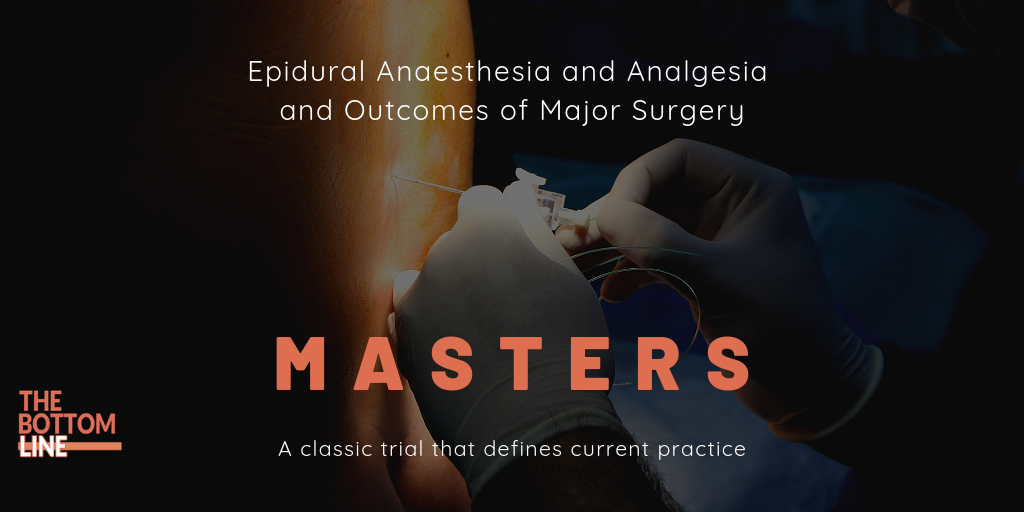MASTERS

Epidural anaesthesia and analgesia and outcome of major surgery
Rigg. Lancet 2002; 359, 1276-1282. doi:10.1016/S0140-6736(02)08266-1
Clinical Question
- In high-risk patients undergoing major abdominal surgery, does epidural analgesia compared with no epidural analgesia reduce mortality and morbidity?
Background
- The use of neuroaxial anaesthesia has long been hypothesised to confer systemic benefits to patients undergoing major surgery by decreasing pro-inflammatory molecules and cytokines by blocking the afferent spinal signals
- This is in addition to the obvious benefits of increased analgesia allowing the patient to breathe deeply, mobilise earlier and to use less opiates
- A meta-analysis of all RCTs looking at neuroaxial anaesthesia and outcome found significant reduction in both morbidity and mortality in patients who received either a spinal or epidural anaesthetic (Rodgers et al, BMJ 2000 – see link)
- However, this was a very broad study question that didn’t have enough power to look at specific subgroups
- Many of the prior studies were very small numbers
- The MASTERS trial group attempted to find test this hypothesis in a large study of high risk abdominal surgery patients
Design
- Multi-national, multi-centre, randomised, controlled trial
- Randomised using random permuted blocks at each site
- 80% power to detect a reduction in incidence of at least one complication from 50% to 40% with a 2-sided alpha of 0.05
- This is based loosely on results from a similar, smaller prior study by Yeagar et al
- Intention to treat analysis
- Combined primary end-point of 30 day mortality OR presence of one major comorbidity, as listed below:
- Respiratory failure (need for re-intubation, PaO2 <50mmHg or PaCO2 >50mmHg on room air)
- Cardiovascular event (AMI, angina, failure, cardiogenic shock, arrhythmia)
- Renal failure (rise in Cr by >100µmol/L, total Cr >300µmol/L or CRRT)
- GI failure (UGI bleeding requiring transfusion or TPN instituted)
- Hepatic failure
- Haematological failure (anaemia, neutropenia or thrombocytopenia)
- Impossible to blind clinicians or research nurses due to evident equipment or physiology related to epidurals
- Attempted to address this by making all data collection based on clinical measurements only. Any uncertainty was reviewed by a blinded committee at study headquarters
Setting
- 25 Hospitals in 6 countries across Australia, South East Asia and the Middle East
- 77.6% of cases recruited in Australia
- However, no differences in patterns of operations or surgical morbidity between sites
- Data collected from July 1995 to May 2001
Population
- Inclusion:
- Adult patients undergoing elective, major abdominal surgery or oesophagectomy with one or more of the following major risk factors:
- Morbid obesity (> 2 x IBW)
- Diabetes
- Chronic renal failure (Cr >200µmol/L)
- Respiratory insufficiency
- Liver disease (Bilirubin >100µmol/L OR bilirubin >40µmol/L with albumin <30g/L)
- Cardiac failure (signs/symptoms of right or left heart failure in preceding 2 years OR LVEF of <35%)
- Acute myocardial infarction (within the preceding 2 years)
- Myocardial ischaemia (history of angina OR demonstrated on exercise/thallium testing)
- Age >75 PLUS two of the following:
- Respiratory disease
- Cardiac dysrrhythmia
- Hypertension
- Moderate obesity (>1.5 x IBW)
- Frailty
- MI at any time
- Adult patients undergoing elective, major abdominal surgery or oesophagectomy with one or more of the following major risk factors:
- Exclusion:
- Age <18 years
- those undergoing surgery within 12 hours of admission
- any contraindications to an epidural procedure
- 920 patients recruited and randomised:
- 456 randomised to Epidural Group
- 2 excluded as already previously randomised for an earlier procedure; 11 excluded due to operation cancellation and 2 due to ineligible procedure
- 441 included in analysis
- Protocol violations:
- 222 cases breached epidural protocol
- Only 225 cases were fully compliant with the protocol
- Multiple reasons including failure to insert, failure to provide analgesia, haemodynamic instability, post-operative sepsis or ‘unknown’
- 464 randomised to Control Group
- 3 excluded as already previously randomised for an earlier procedure; 12 excluded due to operation cancellation and 2 due to ineligible procedure
- 447 included in analysis
- Protocol violations:
- 19 cases received an epidural during the operation or in the subsequent 72 hours
- No reasons given
- 456 randomised to Epidural Group
- Minimal information on baseline demographics provided:
- approx 59% were men and ages were similar
- Four most common operations accounted for 71.3% of all surgeries
- these were bowel, aortic aneurysm, biliary and gastric surgery
- study also included pancreatic, gynaecological and urology surgery
Intervention
- Epidural Group
- General anaesthetic PLUS epidural anaesthesia, sited preoperatively and maintained with a continuous infusion of bupivacaine or ropivacaine until 72 hours after surgery
- If further analgesia required, fentanyl or pethidine used
Control
- Control Group
- General anaesthetic alone with use of intraoperative IV opioid
- Postoperative analgesia primarily by patient or physician-controlled IV opioid infusion, supplemented by NSAIDs, oral opioids and paracetamol
Management common to both groups
- Guidelines provided for preoperative, intraoperative and postoperative management including temperature, replacement of blood and fluids, induction and maintenance of general anaesthesia and general monitoring
Outcome
- Primary Outcome: Combined primary outcome of 30 day mortality OR patients who experience at least one major complication
- Epidural Group: 57.1%
- Control Group: 60.1%
- ARR: 3.72% (95% CI -2.74% to 10.19%;P = 0.67)
-
- No difference in 30 day mortality
- Epidural 5.1% vs Control 4.3%
- P = 0.67
- Reduction of respiratory failure complications in epidural group
- Epidural Group: 23.3%
- Control Group: 30.2%
- ARR: 6.89% (95% CI 1.09% to 12.70%; P = 0.02)
- NNT: 15
- No difference in incidence of any of the other major complication categories between groups
- No difference in 30 day mortality
- Secondary outcomes:
- Small, statistically significant improvement in pain scores on the 10cm visual analogue scale in the epidural group
- Pain score in epidural on average 0.63cm less
- Maximum difference in pain score between groups at a given time was only 1.6cm
- Small, statistically significant improvement in pain scores on the 10cm visual analogue scale in the epidural group
Authors’ Conclusions
- There is no overall difference in mortality or major morbidity in high-risk patients undergoing major abdominal surgery with the addition of epidural anaesthesia to general anaesthesia
- On subgroup analysis, there was a small reduction in respiratory failure in the epidural group
Strengths
- Multi-national, multi-centre randomised controlled trial with all inherent benefits that reduce bias
- Appropriate concealment of allocation prior to randomisation
- Appropriate randomisation method without bias
- Appropriate maintenance of patient within allocated group
- The authors recognised that prior evidence studying this question was insufficient and so attempted to resolve that with this large trial with a focussed question
- No loss to follow-up
- Given that it was not possible to blind the observers to the intervention, they used a pragmatic approach to only collect data of clinical measurements/lab values in order to minimise observer bias
Weaknesses
- Only 50.3% in the epidural group were fully compliant with the protocol
- 60 (13.4%) were removed without documentation of a reason why
- 42 (9.4%) provided inadequate analgesia
- Given only 49.7% of the epidural group received the full protocol, the intention to treat analysis was unlikely to find any significant results
- The protocol for the epidural itself is not in this paper or the protocol/design paper published 3 years earlier
- No information given regarding height of epidural, local anaesthetic choice/dosing or intrathecal opioid use
- No data on block testing/level of block achieved
- No data on dose/medication used in epidural
- Intraoperative infusion vs bolus regime?
- This omission limits the external validity of the results as we are unable to compare the epidural procedure in this study to local practice
- The study protocol states that they measured “cost utilisation end points” including total anaesthesia time, duration of intubation, duration of ICU stay, duration of hospital stay and associated costs, but none of these data are reported in the paper
The Bottom Line
- This study reinforces my current practice where my decision to epidural anaesthesia is on a patient by patient basis and not as a blanket approach to all patients undergoing major abdominal surgery
- The debate on this topic has advanced in recent years with other regional techniques such as rectus sheath catheters becoming more common and very effective
External Links
- [article] Epidural anaesthesia and analgesia and outcome of major surgery: a randomised trial
- [further reading] Reduction of postoperative mortality and morbidity with epidural or spinal anaesthesia: results from overview of randomised trials
- [further reading] Benefits and Outcomes after Epidural Analgesia by Nimmo in BJA Education
Metadata
Summary author: Alex Smith
Summary date: 2 March 2019
Peer-review editor: Duncan Chambler



